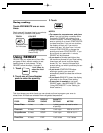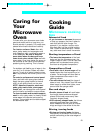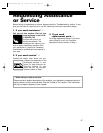
23
USING YOUR MICROWAVE OVEN
Caring for
Your
Microwave
Oven
To make sure your microwave oven looks
good and works well for a long time, you
should maintain it properly. For proper care,
please follow these instructions carefully.
For interior surfaces: Wash often with
warm, sudsy water and a sponge or soft
cloth. Use only mild, nonabrasive soaps or
a mild detergent. Be sure to keep the
areas clean where the door and oven
frame touch when closed. Wipe well with
clean water. Over time, stains can occur on
the surfaces as the result of food particles
spattering during cooking. This is normal.
For stubborn soil, boil a cup of water in the
oven for 2 or 3 minutes. Steam will soften
the soil. To get rid of odors inside the oven,
boil a cup of water with lemon juice or vine-
gar.
For exterior surfaces and control panel:
Use a soft cloth with spray glass cleaner.
Apply the spray glass cleaner to the soft
cloth; do not spray directly on the oven.
NOTE: Abrasive cleansers, steel-wool
pads, gritty wash cloths, some paper
towels, etc., can damage the control panel
and the interior and exterior oven surfaces.
To clean turntable and turntable support,
wash in mild, sudsy water; for heavily soiled
areas use a mild cleanser and scouring
sponge. The turntable and turntable support
are dishwasher-safe.
Cooking
Guide
Microwave cooking
tips
Amount of food
• If you increase or decrease the amount
of food you prepare, the time it takes to
cook that food will also change. For
example, if you double a recipe, add a
little more than half the original cooking
time. Check for doneness and, if neces-
sary, add more time in small increments.
Starting temperature of food
• The lower the temperature of the food
being put into the microwave oven, the
longer it takes to cook. Food at room tem-
perature will be reheated more quickly
than food at refrigerator temperature.
Composition of food
• Food with a lot of fat and sugar will be
heated faster than food containing a lot
of water. Fat and sugar will also reach a
higher temperature than water in the
cooking process.
• The more dense the food, the longer it
takes to heat. “Very dense” food like meat
takes longer to reheat than lighter, more
porous food like sponge cakes.
Size and shape
• Smaller pieces of food will cook faster
than larger pieces and same-shaped
pieces of food cook more evenly than
irregularly shaped foods.
• With unevenly shaped foods, the thinner
parts will cook faster than the thicker
areas. Place the thinner parts of chicken
wings and legs in the center of the dish.
Stirring, turning foods
• Stirring and turning foods distributes
heat quickly to the center of the dish and
avoids overcooking at the outer edges of
the food.
4393787v06(c100).qx 5/6/98 1:51 PM Page 23


















